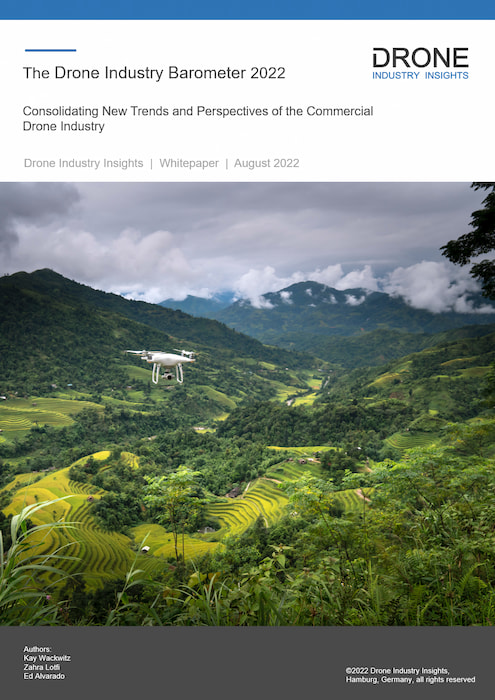

Drone Industry Barometer: Analyzing the Commercial Drone Market in 2022
Every year, we carry out a survey to shed light on the latest insights from the commercial drone market. This results in our annual Drone Industry Barometer, which provides drone companies with an opportunity to both share their views and also to learn from others in the industry. What started as a European-focused drone survey has become a global measure of the industry’s year-to-year performance, and here is a summary of this year’s results.
Scope: Commercial Drone Market Players
Droneii’s annual Barometer is proudly the most global drone survey in the market, and this year it was more international than ever. The survey received 891 responses (an increase of 31% from 2021), coming from 81 countries (vs 64 last year). Although the top ten countries represented roughly 70% of the total responses, these were once again some of the top commercial drone markets in the world (i.e. Japan, USA, Germany, South Korea, Australia, and Switzerland among others). Furthermore, the higher number of countries shows that we continue to make progress on our mission to reach drone companies in every corner of the globe.
In terms of company size, the commercial drone market is still rather startup-driven, so it is no surprise that a majority of respondents (48%) were companies of 10 employees or less. This was followed by companies with a size between 11-50 employees (24%). However, it is worth noting that there were also 30 responses from companies of more than 10,000 employees, meaning that our drone survey reaches everyone from the smallest startups to the largest drone corporations. The high number of big companies that participated also suggests that there may be an increase in drone adoption at large companies, which is a good sign to complement the large amount of startups in the commercial drone market.
Dynamics of the Commercial Drone Market
As we do every year, we asked drone companies about their most-used application methods. Since the question was posed differently this year than in previous years, we cannot compare the results directly. Moreover, this was the case for both Business Internal Services (BIS) as well as Drone Service Providers (DSPs), though BIS were clearly more focused on this method whereas DSPs made almost the same amount of mapping & surveying as they did photography. Inspections remain one of the top application methods, though they are clearly more used as an external service (by DSPs) rather than an internal activity (by BIS).
In previous years, our drone survey only asked the commercial drone market if a particular reason to adopt drones was “not important”, “important” or “very important”, but this year we added two more options to turn the question into more of a scale. This provided us with more interesting data and a less direct outcome. On the one hand, “improving work safety” received the highest amount of “very important” votes, followed by “saving time”. On the other hand “saving time” also received the most “not important” votes, so this year’s results are a lot more heterogenous and the final conclusion about the ”best reason to adopt drones” depends more on the use case.
Want to Know More About the State of the Drone Industry? Check Out Our New White Paper!
White Paper | Drone Industry Barometer 2022
• 891 drone company responses from 81 countries
• Participation from top countries: Japan, USA, Germany, South Korea, Australia, and more
• Top drone application methods as well as top reasons for companies to adopt drones into their workflow
• Comparison of expectations vs reality for drone companies from 2018-2022 (all pandemic years)
• Effects of COVID-19 pandemic after a year of restrictions as well as forecast on long-term impact
• Outlook on what drone companies prioritize and which market-drivers they consider most important
Top Priorities and Market-Drivers
One interesting development in the past years has been the increased importance of marketing & sales for the commercial drone market. Since 2018, the number of companies considering this a top priority has tripled, while the importance of product development (both hardware and software) has been cut in half. In other words, four years ago more companies placed their focus on hardware and software development, but now it is marketing & sales that have become the primary focus.
The second-highest priority according to our drone survey is staff development, which correlates well with the increasing amount of drone jobs available in the commercial drone market and the increased level of effort required in order to find the right talent for the right roles.
Regarding market-driving factors that are out of drone companies’ control, it is once again clear that regulatory frameworks have become the key focus for everyone who makes, sells, uses, or is in any way involved with the commercial drone market. Makers need guidelines (e.g. type certification or other design rules) and operators eagerly await frameworks that will allow them to truly scale unique and profitable operations (e.g. BVLOS or night operations). So regulatory bodies will remain in the spotlight for the development of the industry, and they will largely decide the pace at which it continues to grow.
The Road Ahead
In conclusion, the commercial drone market has continued to push forward through the heavy challenges of the past few years. Although the amount of drone companies who found new use cases during the pandemic went down between 2020 and 2022, the aftereffects of lockdowns and restrictions have decreased even more substantially. Based on our last three barometers, the amount of production and operation shutdowns also decreased dramatically year by year. Therefore, the overall lesson is that the companies who managed to adjust during the pandemic are finally returning to almost-normal operations.
All of this is an encouraging sign for drone companies, and another promising sign is the increased that the industry has received (e.g. for drone deliveries and air mobility). Given the ever-increasing impact of drone regulation as a market-driver and the potential boost in activity that upcoming drone regulations should bring, we are excited to see what the next year will bring for the commercial drone market and we are already looking forward to next year’s drone industry barometer. But in the meantime, we appreciate the support from partners in collecting responses, we are grateful for the drone companies who participated, and we hope all of our audience will enjoy the free white paper.

Before working with drones, Ed acquired vast experience in Communications and Diplomacy. He holds a Master’s in International Relations, Bachelor’s in Economics & Philosophy, and has lived in 7 countries.


